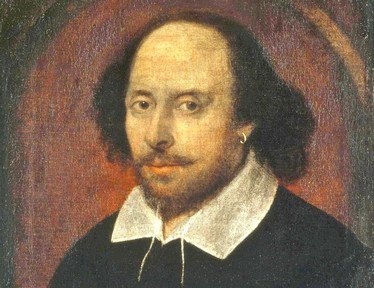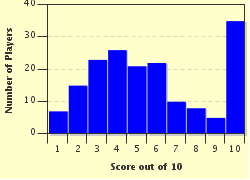Quiz Answer Key and Fun Facts
1. "There's no art To find the mind's construction in the face."
(Macbeth).
One of the earliest pieces of art to possibly depict Shakespeare is called the Grafton Portrait, currently owned by the John Rylands University of Manchester Library in England. Marked "1588" on the back of the frame, what other information indicated that the portrait might be of the Bard?
2. "But by the ear, that hears most nobly of him:
His face I know not."
(All's Well that Ends Well).
One popular picture is the Chandos Portrait (circa 1610), owned at some time by playwright Sir William Davenant (1606-1668). What notable claim did Davenant make in his lifetime regarding Shakespeare?
3. "Or I with grief and extreme age shall perish
And never look upon thy face again."
(Richard III).
The Folger Shakespeare Library in Washington D.C. (U.S.A.) is currently in possession of two controversial Shakespeare likenesses, the Janssen Portrait (circa 1610) and the Ashbourne Portrait (circa 1611). Tests were performed recently on both portraits. What was found out?
4. "And yet me thinks I see it in thy face,
What thou shouldst be: the occasion speaks thee, and
My strong imagination sees a crown
Dropping upon thy head."
(The Tempest).
In 1623, one of Shakespeare's most recognizable likenesses was made by Martin Droeshout. Called the Droeshout Engraving, it was created for the title page of one of Shakespeare's folios, produced by fellow actors Hemminge and Condell with verses by Ben Jonson. Which folio's title page was the engraving for?
5. "God hath given you one face and you make yourselves another."
(Hamlet).
In 1640, a certain William Marshall pointedly followed the quotation by Hamlet. Using the Droeshout Engraving as a reference, he created a slightly different (sitting) Shakespeare engraving for the title page of an authorized edition of Shakespeare's poems. Called the Marshall Engraving, it also included Ben Jonson's verses taken from the folio with the Droeshout Engraving. What did Jonson do to cast doubt on the authenticity of Shakespeare's "Marshall" likeness?
6. "That face of his I do remember well...".
(Twelfth Night).
In 1653, William Dugdale, who was possibly acquainted with Shakespeare in life, made a sketch of the Shakespeare Memorial bust for his publication "Antiquities of Warwickshire". Not only did Dugdale's Shakespeare differ in likeness from the bust currently seen in the Stratford Parish Church, but he, Shakespeare, suspiciously isn't holding the famous quill-pen in his right hand. In Dugdale's sketch, what is Shakespeare holding?
7. "Thou hast the sweetest face I ever look'd on."
(Henry VIII).
One of the most widely distributed Shakespeare likenesses is the Flower Portrait, an oil-on-wood panel with a "1609" inscription. Donated to the Royal Shakespeare Company in Stratford-upon-Avon, England in 1895 by Mrs. Charles Flower, what recent revelation has cast doubt on the painting's claim to be a Shakespeare likeness?
8. "I will go wash; and when my face is fair, you shall perceive whether I blush or no."
(Coriolanus).
In 1861, a restorer from London by the name of Simon Collins was employed to clean and repair some paintings at the Holy Trinity Church in Stratford-upon-Avon. Upon attempting to "wash" a particular portrait owned by Mr. W. O. Hunt, the city's Town Clerk, he removed a full beard a moustache to reveal the image of a man that closely resembled Shakespeare's Memorial bust. What is the name given to this portrait?
9. "Hath my poor boy done aught but well,
Whose face I never saw."
(Cymbeline).
One of the latest contenders was discovered in the spring of 2001. Called the Sanders Portrait, it claims to be a portrait of "Shakspere (sic) at age 39", which would date the painting at 1603. Where was the painting discovered?
10. "In thy face I see the map of honour, truth, and loyalty!"
(Henry VI).
And finally, no quiz on the question of Shakespeare's likeness would be complete without mentioning his controversial death mask, located in Germany in the mid-1800's. What evidence supports the supposition that the mask, a picture of serenity, might indeed be of Shakespeare?
Source: Author
benniebenbenny
This quiz was reviewed by FunTrivia editor
bloomsby before going online.
Any errors found in FunTrivia content are routinely corrected through our feedback system.

